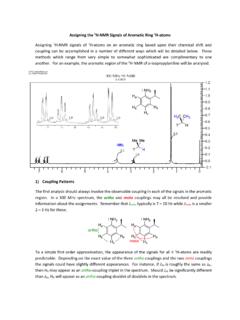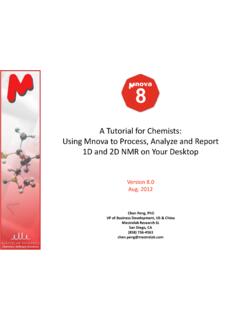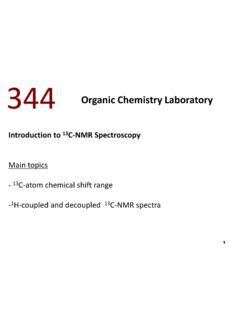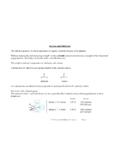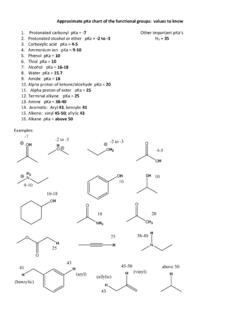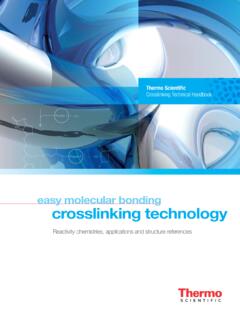Transcription of CHEM 344 Thin Layer Chromatography - Department of …
1 CHEM 344 Thin Layer Chromatography Thin Layer Chromatography (TLC) is a useful technique for the separation and identification of compounds in mixtures. TLC is used routinely to follow the progress of reactions by monitoring the consumption of starting materials and the appearance of products. Commercial applications of TLC include the analysis of urine for evidence of "doping", the analysis of drugs to establish purity or identity of the components, and analysis of foods to determine the presence of contaminants such as pesticides. Introduction Thin Layer Chromatography (TLC) uses the same principles as extraction to accomplish the separation and purification of compounds: that is, the different separation of compounds between two phases based on differences in solubility of compounds in the two phases.
2 In the case of TLC, one phase is a mobile liquid solvent phase and the other phase is a stationary solid phase with a high surface area. The stationary phase normally consists of a finely divided adsorbent, silica (SiO2) or alumina (Al2O3) powder, used in the form of a thin Layer (about mm thick) on a supporting material. The support is usually a sheet of glass or metal foil. The mobile phase consists of a volatile organic solvent or mixture of solvents. A solution of the sample containing a mixture of compounds is applied to the Layer of adsorbent, near one edge, as a small spot. The TLC plate is propped vertically in a closed container (developing chamber), with the edge to which the spot was applied down.
3 The solvent, which is in the bottom of the container, travels up the Layer of adsorbent by capillary action, passes over the spot and, as it continues up, moves the compounds in the mixture up the plate at different rates resulting in separation of the compounds. This process of moving the compounds with the solvent is referred to as elution and the solvents used are eluting solvents. This overall procedure is referred to as "developing" the TLC plate. When the solvent front has nearly reached the top of the stationary phase, the plate is removed from the container, and the solvent front is marked with a pencil. In the diagram to the right, a single spot from a reaction mixture reveals that there are 2 components (A and B) in that mixture.
4 1 Since the amount of adsorbent involved is relatively small, and the ratio of adsorbent to sample must be high, the amount of sample must be very small, usually less than a milligram. For this reason, TLC is often used as an analytical technique rather than a preparative method, although with thicker layers (about 2 mm) and large plates with a number of spots or a stripe of sample, it can be used as a preparative method. For the latter, the separated substances are recovered by scraping the adsorbent off the plate (or cutting out the spots if the supporting material can be cut) and extracting the substance from the adsorbent. Several factors determine the efficiency of a chromatographic separation.
5 The adsorbent should show a maximum of selectivity toward the substances being separated so that the differences in rate of elution will be large. For the separation of any given mixture, some adsorbents may be too strongly adsorbing or too weakly adsorbing. Table 1 lists a number of adsorbents in order of adsorptive power. Silica gel is the most common adsorbent used for routine TLC of organic compounds. Table 1. Chromatographic adsorbents. The order in the table is approximate, since it depends upon the substance being adsorbed and the solvent used for elution. Most Strongly Adsorbent Alumina Al2O3 Charcoal C Florisil MgO/SiO2 (anhydrous) Least Strongly Adsorbent Silica gel SiO2 The eluting solvent should also show good selectivity in its ability to dissolve or desorb the substances being separated.
6 The solubility of different compounds in the eluting solvent plays an important role in how fast they move up the TLC plate. However, a more important property of the solvent is its ability to itself be adsorbed on the adsorbent. To the extent that the solvent has affinity for the adsorbent, it can displace the compounds being separated thereby "pushing" them up the plate. If the solvent is too strongly adsorbed, it can fully displace all compounds causing them to move up the plate together near the solvent front with no separation. If the solvent is too weakly adsorbed, its solvating power alone may be insufficient to move any compounds fast enough to effect separation. Ideally, the affinity of the eluting solvent for the adsorbent is comparable to the compounds being separated causing different compounds to move at different rates resulting in separation.
7 Table 2 lists a number of common solvents in order of increasing eluting strength. The eluting strength of a solvent is primarily related to how strongly it adsorbs onto the adsorbent and because typical adsorbents are highly polar; thus, eluting strength increases with solvent polarity. 2 Mixtures of solvents are employed to achieve optimum separation by TLC. When using solvent mixtures it should be kept in mind that addition of only a minor amount of a polar solvent can result in a large increase in the eluting power of the mixture. Table 2. Solvents for Chromatography Less Eluting Strength (less polar solvents) Pentane, hexane, heptane Toluene, p-xylene Dichloromethane Diethyl ether (anhydrous) Ethyl acetate (anhydrous) Acetone (anhydrous) Acetic acid Ethanol (anhydrous) Methanol (anhydrous) Greatest Eluting Strength (more polar solvents) Although it is possible to make some rough predictions about the relative rate of elution of different compounds with a given adsorbent and solvent (or mixture of solvents) the particular combination that will result in the successful separation of a specific mixture of compounds can only be determined experimentally.
8 One starts by considering what is known about the structures of the compounds to be separated and their relative adsorptivity on the stationary phase. Table indicates an approximate order of adsorptivity of compounds by functional group. Keeping in mind that the solvent is present in great excess over the compounds to be separated, one generally starts with a solvent or mixture of solvents lower in polarity than the most polar compounds in the mixture to be separated. Table Adsorptivity of organic compounds by functional group Least Strongly Adsorbed (less polar compounds) Most Strongly Adsorbed (more polar compounds) Saturated hydrocarbons; alkyl halides Unsaturated hydrocarbons; alkenyl halides Aromatic hydrocarbons; aryl halides Polyhalogenated hydrocarbons Ethers and esters Aldehydes and ketones Carboxylic acids and amines Alcohols 3 Calculating the Rf value of a compound The distance traveled by a compound relative to the distance traveled by the solvent front depends upon the structure of the molecule, and so TLC can be used to identify compounds as well as to separate them.
9 The relationship between the distance traveled by the solvent front and the compound is usually expressed as the Rf value: Rf value = distance traveled by compound distance traveled by solvent front Rf values are strongly dependent upon the nature of the adsorbent and solvent system and thus experimental Rf values and literature values do not always agree. In order to determine whether an unknown compound is identical to a compound of known structure, it is necessary to run the two samples side by side on the same TLC plate, preferably at the same concentration. In general, low polarity compounds have higher Rf values than higher polarity compounds. Summary In general, the adsorptivity of compounds increases with increased polarity ( the more polar the compound then the stronger it binds to the adsorbent).
10 The eluting power of solvents increases with polarity. Therefore, low polarity compounds can be eluted with low polarity solvents, while higher polarity compounds require solvents of higher polarity. The stronger a compound is bound to the adsorbent , the slower it moves up the TLC plate. Non-polar compounds move up the plate most rapidly (higher Rf value), whereas polar substances travel up the TLC plate slowly or not at all (lower Rf value). 4 How to run a TLC plate (student guide) 1. Draw a pencil line about a 1/4 inch from the bottom of the plate (along the short side). Mark places along the line for each spot (pure reference spots and your mixture). 2. Dip the capillary into the solution and gently and quickly place a 1-2 millimeter spot on the plate at the position you ve marked.



